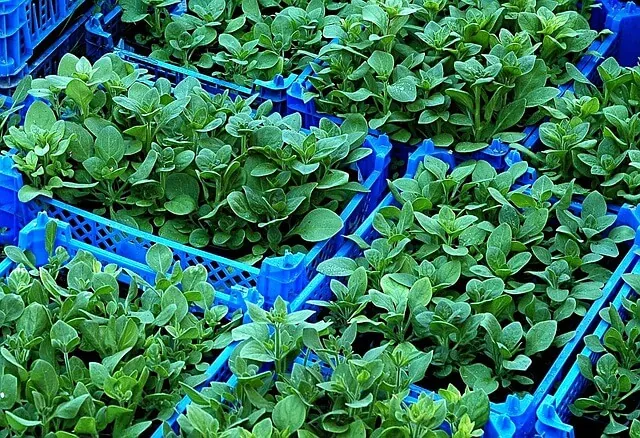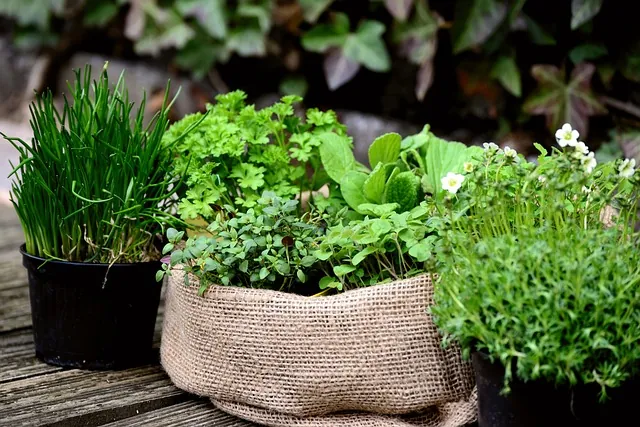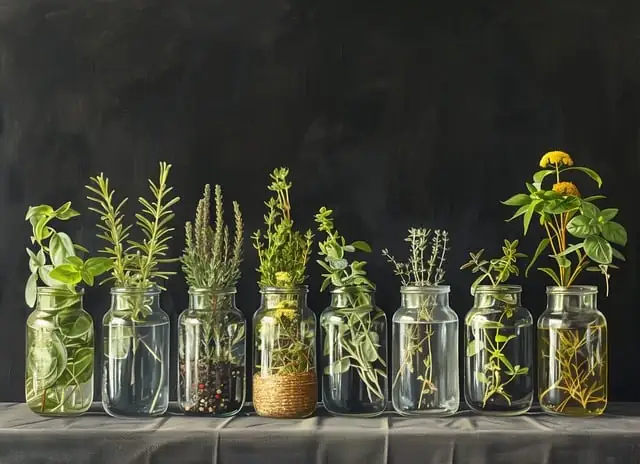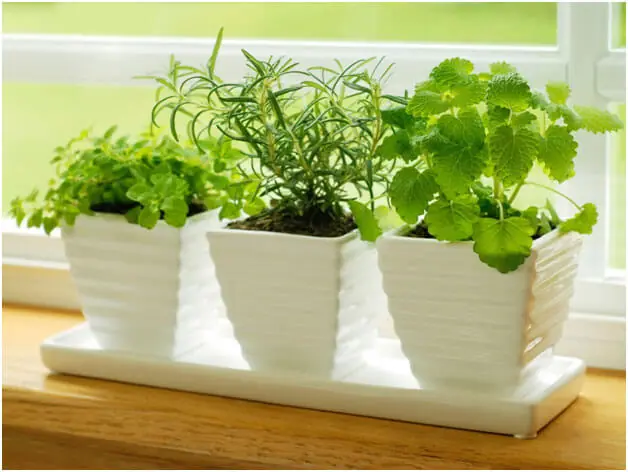 Growing herbs, especially in Large Planters, is a convenient and rewarding way to enjoy fresh, flavourful produce right at your fingertips. Whether you have a small balcony, a rooftop terrace, or a limited backyard space, container gardening offers a versatile solution for cultivating a variety of herbs. In this guide, we’ll provide step-by-step instructions on how to select the right containers, choose suitable herbs, prepare the potting mix, plant your seedlings, provide proper care, and harvest your homegrown herbs.
Growing herbs, especially in Large Planters, is a convenient and rewarding way to enjoy fresh, flavourful produce right at your fingertips. Whether you have a small balcony, a rooftop terrace, or a limited backyard space, container gardening offers a versatile solution for cultivating a variety of herbs. In this guide, we’ll provide step-by-step instructions on how to select the right containers, choose suitable herbs, prepare the potting mix, plant your seedlings, provide proper care, and harvest your homegrown herbs.
For a more design specific guide to growing herbs we have: Incorporating Herbs Into Your Landscape
Follow these seven steps on how to grow herbs in a container garden right from your own garden pots and planters:
Choice of Herbs
When planning to grow herbs, begin by deciding which herbs you will grow in your containers. Your first reason to consider any herb has to be its taste. In your planters, you should always grow herbs that compliment other vegetables you have planted in your garden. Most herbs are very easy to grow.
Placing your Container Garden
Depending upon the nature of herbs, you should consider the right location for your planter. Most herbs are adapted to bear heavy sunlight. An ideal location to place your herb garden would be your patio which is bound to get a lot more sunlight as compared to any indoor location.
English organic gardening expert and author, Jekka McVicar, says that when planning your garden, you can divide your plants into two sections.
Thyme, sage, rosemary, French tarragon and oregano that like full sun; and those that like partial shade, such as rocket, sorrel, mizuna, mustard, parsley and chervil.
Seeds or Seedlings
With seeds, you will have a wider variety of herbs and they are very easily accessible. Seedlings on the other hand will give you quicker results. They are hassle-free as germination and transplanting will not be required.

Drainage
Make sure that your garden pots have large holes in the bottom to drain water properly. Herbs can rot in a lot of water. Also try using larger containers for herbs because the soil would absorb enough water for them to grow properly. You can also grow more herbs in one container instead of using smaller pots.
Using Potting Mix
 Generally for container gardening and specifically for growing herbs in planters, potting mixes are recommended instead of regular potting soil. These mixes have an ideal combination of balanced pH and nutrients for optimum growth of plants.
Generally for container gardening and specifically for growing herbs in planters, potting mixes are recommended instead of regular potting soil. These mixes have an ideal combination of balanced pH and nutrients for optimum growth of plants.
Use Special Fertiliser
Some fertilisers maximise the production of flowers while inhibiting the growth of leaves. For herbs, you should go for fertilizer designed for culinary herbs as you want the leaves to reach their maximum growth limit.
When Growing Different Herbs
Make sure that you grow compatible herbs in a container so their requirements of water and sunlight do not clash. Herbs with contrasting natures should be planted in separate planters so they do not rot or damage others.

5 Must Have Herbs for Your Container Gardens
When planning a container garden for herbs consider the following:
Mint
Mint is one of the most used herbs. Place your mint planter near your kitchen door for a ready supply. It is a fast growing herb and if you want to keep it pure, plant mint plants close to each other so cross pollination becomes easier.
Thyme
Thyme requires very little maintenance and is ideal to grow in a container. It thrives on less water. Usually used as decorative plants, thyme is an under-rated herb as it brings out great flavours in everyday food.
Rosemary
Growing rosemary in a separate container is recommended as it has peculiar watering requirements. It wilts in a lot of water and dries out frequently between watering sessions.
Basil
It requires a lot of water to keep its stem and leaves healthy. Basil is prone to mildew so having it in a separate container is better.
Sage
It requires more maintenance than other herbs and replacing it after 3 years is recommended. Sage grows at a fast pace but needs to be pruned regularly to grow properly.

Attract Pollinators
Attracting pollinators to your potted herb garden is essential for promoting healthy growth and maximizing your herb yield. Bees, butterflies, and other pollinators play a critical role in transferring pollen from the male to the female flowers, which leads to the production of fruit or seeds. To attract pollinators to your herb garden, plant a variety of herbs that bloom at different times throughout the growing season. Choose herbs with bright, colorful flowers, such as lavender, thyme, and rosemary, which are attractive to pollinators. Additionally, avoid using pesticides and insecticides, which can harm pollinators and other beneficial insects. Instead, use organic pest control methods.
Pruning
Pruning is an essential practice for maintaining the health and productivity of your herb garden. Regular pruning not only helps to control the size and shape of your plants but also promotes new growth and improves the flavor of your herbs.
When pruning your herbs, it’s important to use clean and sharp tools to avoid damaging the plant. You can use scissors, pruning shears, or a sharp knife to cut the stems at a 45-degree angle just above a leaf node. This will encourage new growth and prevent the stem from rotting.
The timing and frequency of pruning depend on the type of herb you are growing. For instance, woody herbs such as rosemary and thyme require less frequent pruning, while leafy herbs like basil and mint benefit from regular pruning to encourage bushier growth and prevent them from becoming leggy.

Harvest Your Herbs
Harvesting your herbs at the right time is crucial for ensuring the best flavor and aroma. Most herbs are ready for harvesting when they have developed a strong and distinct aroma, and their leaves are fully grown. Here are some tips on how to harvest your herbs:
- Timing: The timing of harvesting varies depending on the type of herb. For instance, leafy herbs such as basil, mint, and cilantro should be harvested before they flower, while woody herbs such as thyme, rosemary, and oregano can be harvested throughout the growing season.
- Technique: To harvest your herbs, use clean and sharp scissors or pruning shears to cut the stems just above a pair of leaves. Make sure not to remove more than one-third of the plant at a time, as this can weaken the plant and affect its growth.
- Storage: Once harvested, rinse the herbs under cold running water to remove any dirt or debris. Shake off any excess water and pat the herbs dry with a clean towel. Store the herbs in airtight containers, such as plastic bags or glass jars, and keep them in the refrigerator to extend their shelf life.
- Preservation: If you have a surplus of herbs, you can preserve them by drying or freezing them. To dry herbs, tie them into small bundles and hang them in a warm, dry, and well-ventilated place for a week or until they are dry and crumbly. To freeze herbs, chop them finely and pack them into ice cube trays with a little water or olive oil, then freeze them until solid. You can use the frozen herbs in soups, stews, and sauces throughout the year.
Final Thoughts
Container gardening is a fantastic way to make the most of small spaces and enjoy the beauty and bounty of plants. Growing herbs in your garden pots is a particularly rewarding experience, as it allows you to savour the fresh aroma and flavour of homegrown herbs right in your kitchen. By following the seven simple steps outlined in this guide, you can easily create a thriving herb garden in your own containers. So why wait? Start planting today and enjoy the delicious and fragrant rewards of your homegrown herbs!



I have heard that having lots of mint varieties and cross pollinating can lead to lesser tasting hybrid varieties have you heard of this before.
No, that one is news to me, and I have not experienced it personally